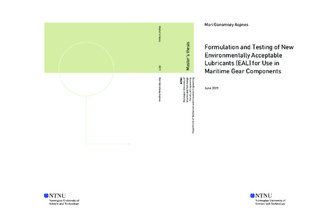Formulation and Testing of New Environmentally Acceptable Lubricants (EAL) for Use in Maritime Gear Components
| dc.contributor.advisor | Espallargas, Nuria | |
| dc.contributor.author | Aspnes, Mari Gansmoøy | |
| dc.date.accessioned | 2019-10-18T14:10:22Z | |
| dc.date.available | 2019-10-18T14:10:22Z | |
| dc.date.issued | 2019 | |
| dc.identifier.uri | http://hdl.handle.net/11250/2623259 | |
| dc.description.abstract | I marin industri er lekkasje av smøremidler en stor miljøutfordring. For å redusere slik forurensning til sjøvannet må alle fartøy benytte miljøvennlige smøremidler i all olje til sjø grensesnitt. I disse grensesnittene kan sjøvann forekomme og det er derfor viktig at smøremiddelet har evnen til å absorbere vann i systemet. I dag blir syntetiske estere hovedsakelig brukt som base i smøremiddelet. Ulempen med syntetiske estere er at de hydrolyserer i kontakt med vann, noe som kan føre til nedbrytning av smøremiddelet og skade på komponenter i systemet. I denne studien ble de tribologiske og reologiske egenskapene til to miljøvennlige baseoljer, en polar (glyserol) og en upolar (polyalphaolefin) base med fire forskjellige miljøvennlige additiver undersøkt. Det ble benyttet en type karboksylsyre og tre forskjellig typer ioniske væsker som additiver. De reologiske egenskapene til vannløsninger av glyserol, PAO og tre forskjellige kommersielle EALs ble testet. De tribologiske egenskapene ble testet ved bruk av en "pin on disk"-test og slitasjesporene ble så undersøkt. De tribologiske og reologiske testene viste at glyserol byr på utfordringer når det kommer til løselighet av additiver og at mengden av vann påvirker denne løseligheten. Friksjonsegenskapene til PAO ble forbedret ved tilsetning av karboksylsyre. Glyserol hadde høyere slitasjevolum enn både vann og PAO. Dette indikerer at polariteten til baseoljen påvirket slitasjeegenskapene hos smøremiddelet. Resultatene viste også at polariteten ikke påvirket friksjonsegenskapene. | |
| dc.description.abstract | In the marine industry the leakage of lubricants into the sea has been a big environmentally challenge. In order to reduce damage to the environment vessels must use environmentally acceptable lubrication (EAL) in all oil to sea interfaces. In these interfaces there is a chance for seawater to enter, it is therefore important that the lubricant can absorb water in the system. Today synthetic esters are commonly used as EALs, but the drawbacks with these are that they hydrolyze in contact water, which can cause problems in the gear components and lead to lubricant failure. To address this problem the tribological and rheological properties of two possible environmentally acceptable base oils, one polar (glycerol) and one non-polar (polyalphaolefin) with four types of different environmentally acceptable additives were investigated. The additives were one type of carboxylic acid and three types of ionic liquids. The rheological properties of glycerol aqueous solution, PAO, and three types of commercially available EALs were tested. The tribological performances of the solutions were tested with the use of a pin on disk test and the wear tracks were investigated. The tests showed that glycerol aqueous solutions had difficulty with the solubility of additives and that the amount of water affected this solubility. PAO, on the other hand, showed improved tribological performance with the addition of carboxylic acid. Glycerol showed a higher wear rate on the worn surface compared with water and PAO. The polarity of the two base oils did not influence the frictional performances. However, the results showed that the polarity influenced the wear rate significantly. | |
| dc.language | eng | |
| dc.publisher | NTNU | |
| dc.title | Formulation and Testing of New Environmentally Acceptable Lubricants (EAL) for Use in Maritime Gear Components | |
| dc.type | Master thesis |
